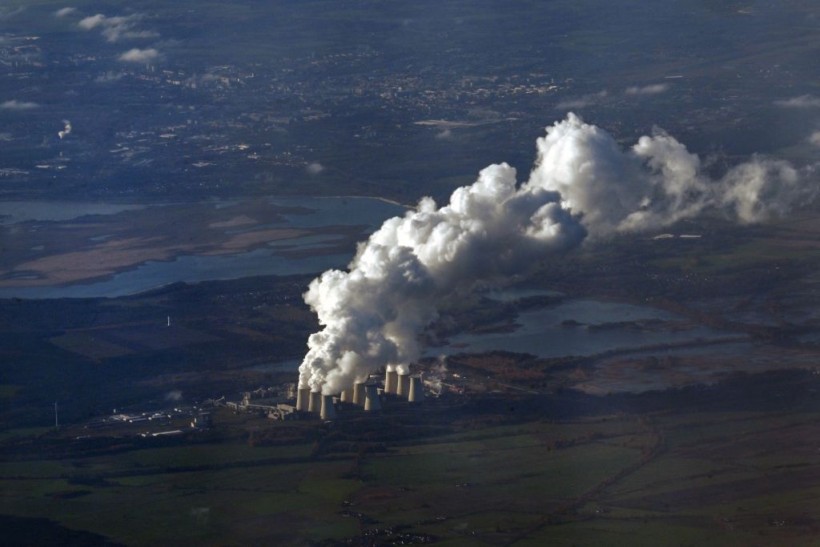A new study by a team of scientists from University of Miami Rosenstiel School of Marine, Atmospheric, and Earth Science has revealed that CO2 absorbs more infrared radiation as the temperature rises, creating a positive feedback loop that accelerates global warming.
CO2: A Selective Absorber of Infrared Energy
 (Photo : INA FASSBENDER/AFP via Getty Images)
(Photo : INA FASSBENDER/AFP via Getty Images)

When sunlight reaches Earth, some of it is reflected into space, and some of it is absorbed by the surface and the atmosphere.
The absorbed energy is then re-emitted as infrared waves, which we feel as heat. However, not all of the infrared waves can escape back into space, because some of them are intercepted by greenhouse gases, such as CO2, that act like a blanket over the Earth.
Greenhouse gases are selective absorbers of infrared energy, meaning that they only interact with certain wavelengths of radiation.
For example, CO2 absorbs energy at a variety of wavelengths between 2,000 and 15,000 nanometers, which overlaps with the range of infrared energy emitted by the Earth.
As CO2 soaks up this infrared energy, it vibrates and re-emits the energy back in all directions. Some of the energy goes out into space, and some of it returns to Earth as heat, contributing to the greenhouse effect.
CO2: A Variable Greenhouse Gas
The greenhouse effect of CO2 is not constant but depends on several factors, such as the concentration of CO2 in the atmosphere, the temperature of the Earth, and the amount of water vapor in the air.
The new study, published in the journal Nature Communications on November 29, focused on the effect of temperature on CO2's radiative forcing, which is a measure of how much CO2 alters the energy balance of the Earth.
Using satellite data and computer models, the researchers found that CO2 becomes a more effective greenhouse gas as the temperature increases.
This is because higher temperatures cause the Earth to emit more infrared energy, especially at the wavelengths that CO2 can absorb.
As a result, CO2 captures more heat and enhances the warming of the planet.
The study estimated that for every 1°C increase in global mean surface temperature, CO2's radiative forcing increases by about 0.2 watts per square meter.
This means that as the climate responds to the increases in CO2, CO2 itself becomes a more potent driver of climate change, creating a positive feedback loop that amplifies the warming.
Also Read: Moisture Is an Important Regulator and Sequestrant of Soil Carbon Stocks [STUDY]
CO2: A Major Challenge for Climate Action
The findings of the study have important implications for climate action, as they suggested that the current projections of future warming may be underestimated.
The study also showed that the temperature dependence of CO2's radiative forcing varies across different regions of the world, with the largest effects occurring over the tropics and the polar regions.
This means that some areas may experience more warming than others due to the enhanced greenhouse effect of CO2.
The study's lead author, Dr. Zaichun Zhu from Peking University, said that the results highlight the urgency of reducing CO2 emissions to limit the risks of climate change.
He explained that as the climate changes due to the increases in CO2, CO2 itself becomes a stronger greenhouse gas, which could make it harder to achieve the goals of the Paris Agreement.
The Paris Agreement is a global treaty that aims to limit the rise in global average temperature to well below 2°C above pre-industrial levels and to pursue efforts to limit it to 1.5°C.
To achieve this, the world needs to reach net-zero CO2 emissions by the second half of this century, which means that any CO2 emitted must be balanced by an equivalent amount of CO2 removed from the atmosphere.
However, according to the latest report by the World Meteorological Organization, the concentrations of CO2 and other greenhouse gases in the atmosphere reached new record highs in 2022, despite the temporary reduction in emissions caused by the COVID-19 pandemic.
The report warned that the continued increase in greenhouse gases will fuel more extreme weather events, such as heat waves, droughts, floods, and storms, and threaten the lives and livelihoods of millions of people.
The report's secretary-general, Prof. Petteri Taalas, said that the world needs to act urgently and decisively to cut greenhouse gas emissions and achieve net zero by 2050.
He stated that the time to avert catastrophic climate change is running out and that the window of opportunity is closing fast.
Related article: Greenhouse Gases Carbon Dioxide and Methane Dramatically Increase by 0.6% and 0.5% in 2022 [Study]
© 2024 NatureWorldNews.com All rights reserved. Do not reproduce without permission.



![Climate Change is Reducing Dust Levels Worldwide as Arctic Temperature Warms [Study]](https://1471793142.rsc.cdn77.org/data/thumbs/full/70320/280/157/50/40/climate-change-is-reducing-dust-levels-worldwide-as-arctic-temperature-warms-study.jpg)

